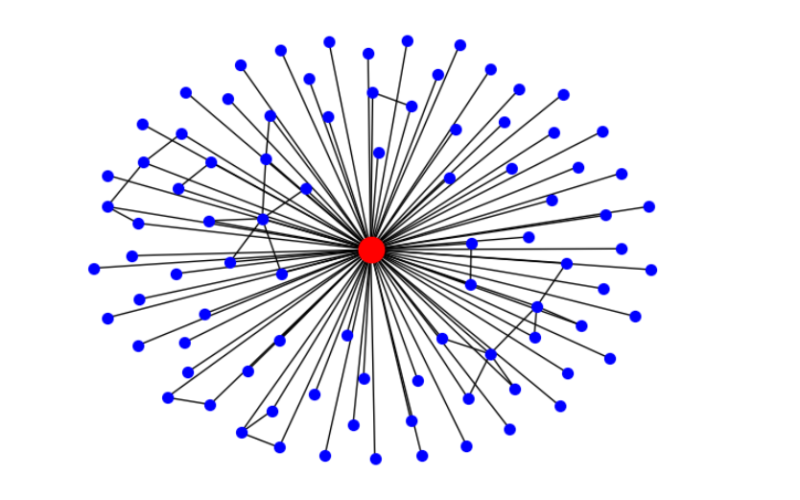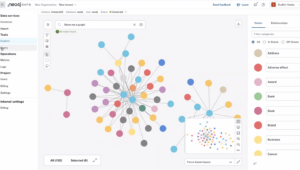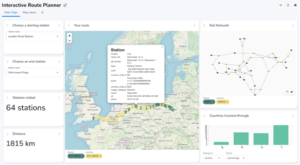Ego Graph algorithm (source: NetworkX.org)
Neo4j today took the wraps off several major improvements to its cloud-based graph database, dubbed Neo4j AuraDB, including a new GenAI-infused console, an interactive dashboard builder, a new Business Critical tier that’s 20% less expensive than the tier it replaces, and a 15X improvement in real-time read capabilities.
The emergence of generative AI is fueling new demand for graph databases, which previously were used in somewhat niche applications like fraud detection. That’s good news for Neo4j, which holds the advantage of being the first mover in graph databases and is still the biggest player, as the company is keen to serve new GraphRAG (graph plus retrieval augmented generation) use cases.
With today’s updates to its managed graph database for the cloud, Neo4j AuraDB, the San Mateo, California-based company is working to make it easier for users to get started with its graph database.
For starters, Neo4j today is launching a new AuraDB console designed to unify all the tools not just for setting up and managing a graph database cluster, but also using the database to explore and visualize data.
That’s a big departure from AuraDB’s previous console, which was primarily designed for administrators, says Sudhir Hasbe, Neo4j’s chief product officer.
“What we are doing is we are bringing all of the graph tooling for graph analysis and graph visualization…into a single console, so customers don’t have to leave one interface to get full value,” Hasbe says. “So you will be able to go from ‘create the instance’ to ‘I want to deploy my data into it’ and import it, to visualize it, query it, visualize it, and then actually run algorithms on it. That happens in a single unified console.”
Making all of Neo4j’s tools accessible from a single console will significantly reduce barriers to getting started, Hasbe says. What’s more, Neo4j has also added its natural language-powered copilot into the console, which will make the experience even simpler.
“You don’t even have to learn our language [Cypher]. You just basically start saying, hey, just query the graph for all the information,’ and then it will give you a query and you’ll be able to run it,” Hasbe says.
Neo is also formally launching an interactive dashboard called NeoDash as part of AuraDB. NeoDash is an open source offering that allows users to uses low code/no code techniques to understand, analyze, and interact with their graph data.
Neo4j is turning NeoDash into a fully supported product, Hasbe says.
“It was basically a labs project,” he tells Datanami. “It was open source, not supported. It was not managed as a product. It was more like a hey, here’s a free stuff, go take it, run it at your own risk. And so we are productizing it more. It has its own engineering team now we are basically converting it into supported products.”
NeoDash has a different use case and targeted users than the AuraDB Console. NeoDash is primarily designed for folks who need to consume the results of graph database or graph analytics, but not necessarily explore the database or developed queries. For those more technical uses, the Aura Console is preferred, Hasbe says.
With that said, NeoDash will also be available within the AuraDB Console in the coming quarters, according to Hasbe, who previously ran the analytics and database team at Google Cloud.
Neo is also launching a new tier, dubbed AuraDB Business Critical, at a 20% discount compared to the old Neo’s AuraDB Enterprise offering. The company is also renaming AuraDB Enterprise as AuraDB Virtual Dedicated Cloud.
“We are now creating this Business Critical edition, which basically, with a few clicks, you can just go from your app that you have built to make it highly available on a multi-machine cluster,” Hasbe says.
Customers can get up to half a terabyte (512GB) of RAM with the AuraDB Business Critical edition and the Virtual Dedicated Cloud. A cluster that size will support a graph with hundreds of millions of nodes, Hasbe says. “We will be enabling a terabyte of RAM in the coming quarter,” he says. “So we are going higher and higher machines.”
If customers need more throughput for reading from the Neo4j graph database, they can tap into another new capability the company is unveiling today: a 15X increase in scale-out read capacity.
“Basically the cluster goes from three machines to three plus 15 machines, which will be up to an 18-machine cluster that that will be formed,” Hasbe says. “The three machines are still the primary three machines for transaction management and the other machines do asynchronous write so that you can use them for read throughput.”
This 15x speedup will be beneficial for certain read-intensive workloads, such as graph queries. It won’t help other workloads that are more write-intensive, such as transaction processing (Neo’s graph database is used in some transaction processing environments, too).
Finally, Neo4j is also bolstering security in AuraDB with new features like support for fine-grained access control, support for encryption in transit and at rest, support for single sign-on via IDPs like AAD and Okta, and support for private VPCs and Private Links.
All of the AuraDB enhancements are available across all three major clouds. Neo4j is making these announcements on the eve of its GraphSummit enterprise conference in New York City. This is the first of four GraphSummit events that Neo4j will host this year, Hasbe says, and about 500 people have already preregistered for it.
Related Items:
Neo4j Finds the Vector for Graph-LLM Integration
Neo4j Releases the Next Generation of Its Graph Database
Neo4j Drives Simplicity with Graph Data Science Refresh
Source link
lol



